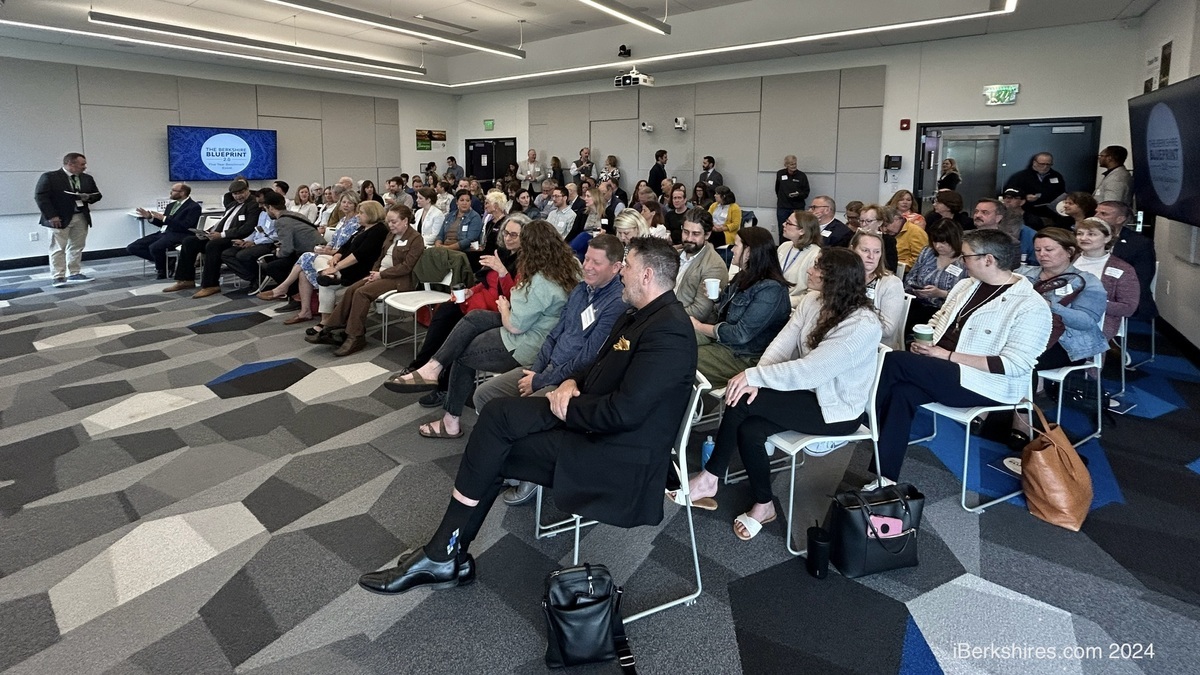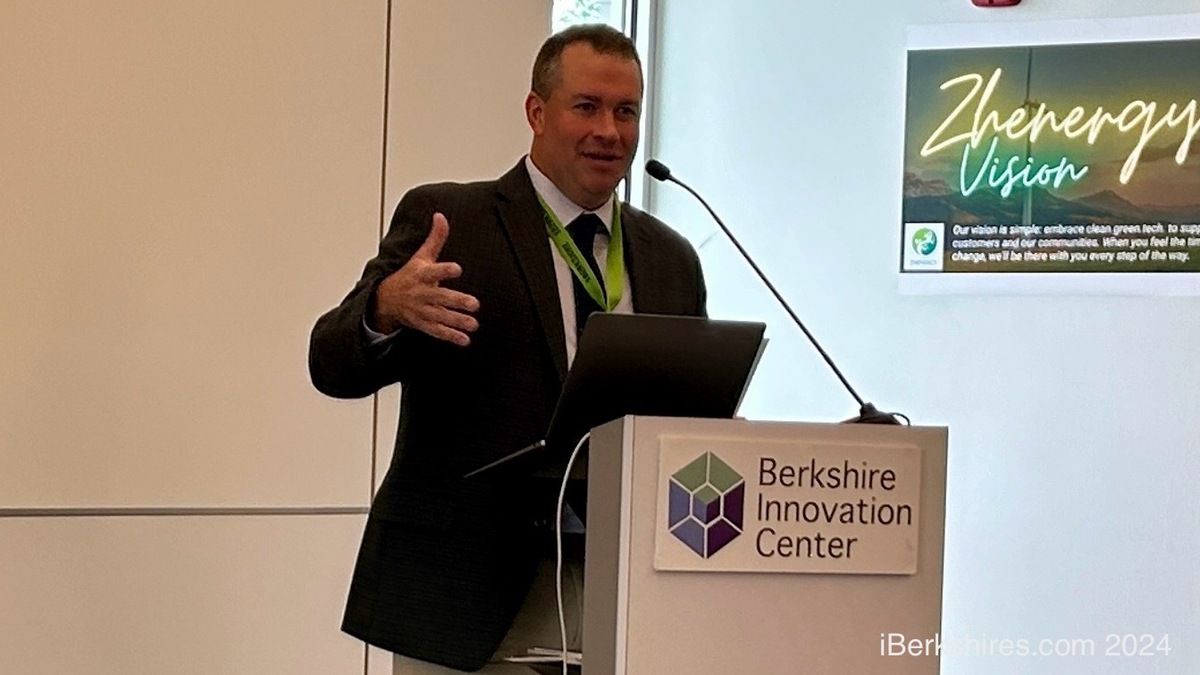
1Berkshire Marks Halfway Point of Pandemic-Altered Blueprint

PITTSFIELD, Mass. — 1Berkshire's blueprint for economic development was adaptable when it needed to be and today, paves steps for a post-pandemic Berkshire County.
1Berkshire marked five years since the Berkshire Blueprint 2.0 release with a progress report May 30 on the plan shaped by the pandemic's impact on the region and beyond.
President and CEO Jonathan Butler noted that it was an intentional decision to deliver the update from the Berkshire Innovation Center, which was being built when the blueprint was released.
"On the one hand, it's hard to believe that it's been over five years since (Vice President of Economic Development Benjamin Lamb) and myself stood in front of nearly 300 people at the Colonial Theatre attempting to explain this whole framework that we call the Berkshire Blueprint," he said.
"But on the other hand, 2019 is in the very distant past. We've seen the world change, the region change, and plans change. We've lived and worked through a pandemic that consumed nearly three years of our lives and continues to influence it today. Yet, despite all of that, we stand here today at the halfway point of a regional strategy that is still very active but like each of us, has had to pivot, adjust, and rethink its priorities."
Five years ago, the "last thing on our mind was the thought of a life-altering pandemic," he said, but that is exactly where they were a year later with the Berkshire Blueprint 2.0. The 10-year plan was released in February 2019 after two years of planning and adjusted to the pandemic after its onset.
"The impacts of the pandemic are vast, complicated, and will continue to influence how business is done in the Berkshires and beyond for years, if not decades, to come," Butler said. "And that was something that we did not plan for."
Lamb noted that recovery and resiliency really became the focus post-pandemic.
"Whether that was technical assistance or was offering new services or resources to help businesses and individuals to rebound, which we've seen an immense amount of, let's not shake our fist at that. That's actually been really amazing to see," he added.
"But that secondary layer is resiliency and looking at the work of like (Berkshire Regional Planning Commission) and other entities that have actually started to build structures around how do we effectively support businesses for the next thing that's coming down the pike."
Butler admitted that five years ago, the plan missed housing as a potential area of crisis.
"It was alluded to in that work, but it wasn't really one of those issues that really floated to the surface and it wasn't until 2020 with the pandemic effects really emerging and the impacts of that in our community that would begin to wrap our collective minds around the depth of the problem and how significantly it was impacting every walk of life in the Berkshires and beyond," Butler said.
"So while both the pandemic and the housing crisis were curveballs for the Berkshires, the blueprint significantly strengthened our ability to respond to both. It didn't necessarily do that by calling out specific solutions from a report that was developed throughout 2017 and 2018 but instead, by helping us establish a framework from which we communicate, collaborate, and collectively work together towards improving the common quality of life here in the Berkshires."
In late 2020, 1Berkshire and the BRPC assembled a working group of regional partners and created A Housing Vision For The Berkshires, which identifies critical issues and 62 strategic actions to solve them.
Issues such as unaffordability, scarcity, declining stock, and lack of resources were called out among many others. Strategies are categorized into four broad categories: education, advocacy, financial resources, and building a supportive environment.
The blueprint urges the adoption of these recommendations and for support from the business community on housing developments, especially in response to local "not in my back yard" opposition.
Lamb reported that the county went from a housing crunch, which was sort of there, to a housing crisis "quite quickly" over the last five years.
"Housing. Housing, housing, housing, housing, housing. Regardless of the conversation you're having, it's going to come into play, whether its residents, workforce, economic development, redevelopment, blight, whatever the case might be," he said, adding that it "is going to take everyone to pull the rope" to close the gap.
Housing and diversity, equity, and, inclusion were added to the four cross-cutting issues originally identified: broadband, energy, population and workforce, and transportation.
Because of the boom in outdoor recreation as a popular socially distant activity during the pandemic, it was made a new cluster. There are now six: advanced manufacturing and digital enterprise, creative economy and culture, food and agriculture, health and wellness, hospitality and tourism, and outdoor recreation.
"Back in 2021, one of the big shifts that occurred was a recognition that outdoor recreation was seeing a massive amount of investment. It was also seeing a huge influx of users as we saw all these folks kind of in an exodus from urban centers and metro areas coming to the Berkshires to benefit from what we already have in our backyard," Lamb said.
"And so that asset that we had in our back pocket really started to see a massive economic impact as the driver of much of the visitorship that we saw during the pandemic."
The blueprint highlights an influx of more than $100 million in recent investments and outdoor recreation facility upgrades, an "extended regional awareness of the outdoor recreation resources of the Berkshires," and the cluster accounting for over 6,000 full-time and seasonal jobs in the county.
EforAll and the Blackshires were spotlighted as local entities that emerged during this time and are prime examples of the Berkshire Blueprint 2.0's goals.
Entrepreneurship for All is a nonprofit organization that partners with communities nationwide to help underrepresented individuals start and grow businesses through intensive business training, mentorship, and an extended professional support network.
EforAll Berkshire County Executive Director Allison Schmitt highlighted the program's successes over the last few years. A survey response by 46 of the 68 participating businesses revealed that $1.3 million was generated from EforAll participants, more than double the amount in 2022.
"Next year will be our five-year anniversary and we'll have well over 100 alumni definitely," Schmitt reported. "So we're really excited to continue supporting small business in the Berkshires and just a quick reminder to buy local."
The Blackshires is a community-owned and curated platform for the empowerment of the Black community in the Berkshires. The organization has a leadership accelerator program that provides support for people looking to take projects to the next level. Twenty-four local leaders completed the 2023/2024 cohort, 80 percent from Pittsfield's Morningside and West Side neighborhoods, and there was more than $40,000 in scholarship funds and stipends and over $48,000 in completion grant funds distributed.
Co-founder John Lewis and President Dubois Thomas spoke on the program's impact.
"We believe in the power of unity and collaborations, bringing together individuals from diverse backgrounds to work towards community goals, and we are proud to say that we have engaged over 15 organizations as partners to this program," Lewis said, explaining that the Executive Office of Housing and Urban Development's Urban Agenda Grant sparked the program.
He added that the Blackshires also marks a commitment to tearing down the barriers that have historically held back communities and that they are actively working to rewrite the narrative of leadership to be more inclusive and representative.
"This is a great program that kind of immediately ingratiates you into the community not only within Black leadership but also, week to week you are meeting with all the leaders from the City of Pittsfield, leaders from Berkshire Bank, leaders from 1Berkshire, etc., etc., etc.," Thomas added.
"It's a great way to accelerate your leadership in Berkshire County."
The event ended with a video about the origins of the Stationery Factory and its impact since. Stephen Sears and his wife, Maria Cruz, tell the story of testing their luck on an old factory building and finding a tight-knit community within, revamping it into the mecca of activity it is today while preserving the building's history.
"We thought about what might we feature and how can it connect to the blueprint and someone on our team suggested, 'Well, why not the Stationery Factory?' and kind of without hesitation, everybody at the table just nodded our heads and said, 'Yeah,'" Butler said.
"We've been around the Stationery Factory as an organization and our partner organizations have, watching it from its infancy to 10 years ago to where it is today. It is a building that is a microcosm of economic development, true economic development, and raw economic development, here in the Berkshires. There are over 25 businesses in that building, and over 100 people call that place their home for work on a daily basis."
"When we think about the blueprint and how it's divided by sector, that facility the Stationery Factory is a literal microcosm of the blueprint with all those sectors represented by the small businesses within it."
Tags: 1Berkshire, blueprint,















